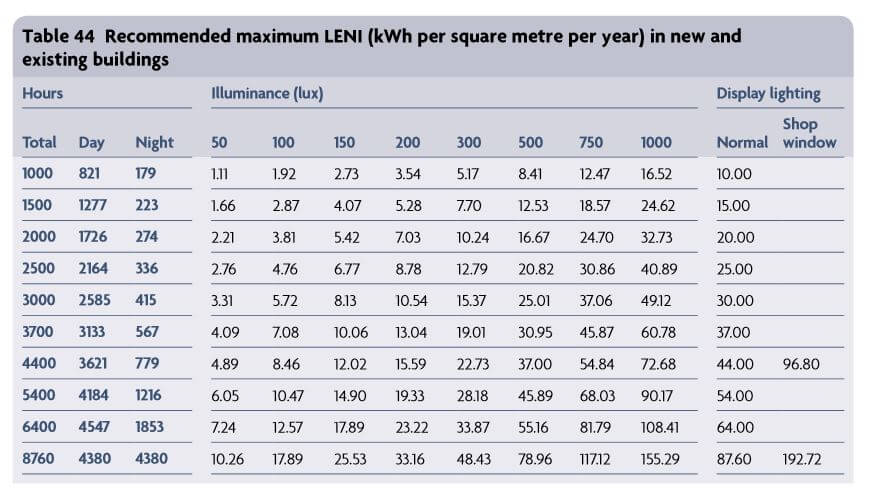LENI: Lighting Energy Numerical Indicator
LENI values have been around for approximately 10 years now, however with more and more planning specifications now requiring the calculation of LENI values, they are starting to become a necessity for all good lighting designs. In this guide, we will try to explain exactly what the LENI is, the factors that go into calculating the value and how you can calculate it yourself using both the simple and detailed methods.
If all that fails and you still require some help with you LENI calculations please do contact us, as we would love to help.
What is LENI (Lighting Energy Numerical Indicator)?
The LENI (Lighting Energy Numerical Indicator) method provides an alternative way of calculating the lighting energy performance of a building. Whereas each luminaire is usually assessed for its energy efficiency (for example a luminaire with no controls should have a minimum efficiency of 60 luminaire lumens per circuit watt), the LENI method calculates the actual energy used in KWh per square meter per year. This figure is then assessed against a maximum benchmark value depending on the illuminance (lux) required within a room.
Having an alternative method of demonstrating the compliance of the lighting systems provides engineers with much greater flexibility in their design, allowing for a wider array of lighting types, systems, and controls to be used.
How to Calculate the LENI Value?
There are two main methods of calculating the LENI value of a room. The first is the simple method set out within the 2013 Non-Domestic Building Services Compliance Guide. The second is the more detailed and accurate method set out within the BSI British Standard BS EN 15193:2007 Energy Performance of Buildings – Energy Requirements for Lighting.
For the most accurate results, whichever method you decide to use, the LENI calculations should be carried out on a per room basis (as different rooms such as offices and circulation areas are likely to have very different luminaire types and control systems).
No matter what method you prefer to use, there are some variables that are common to both that you will need to know before undertaking the calculations. These are defined below:
Total Installed Lighting Power (Pn) – The total power in watts for all the luminaires within a room/area.
Total Installed Control Parasitic Power (Ppc) – The total power in watts of all the control systems within a room/area when the lamps are not in use.
Total Installed Emergency Lighting Charging Power (Pem) – The total charging power in watts of all emergency luminaires in a room/area.
Standard Year Time (ty) – Time in hours in one year, taken as 8760 hours.
Daylight Operating Hours (td) – Operating Hours of the lighting when daylight is present.
Non-Daylight Operating Hours (tn) – Operating Hours of the lighting when daylight is not present.
Emergency Lighting Charging Hours (te) – The number of hours during which the emergency lighting batteries are charged.
The following control factors are used within both the Simple and Detailed calculation methods, however their values can change depending on the method used. To determine your occupancy, daylight and constant illuminance factors please see either the 2013 Non-Domestic Building Services Compliance Guide for the simple method or the BS EN 15193:2007 standard for the detailed method.
Occupancy Factor (Fo) – The factor that relates to the lighting power when occupancy controls are in place. Depending on the type of occupancy control this value will vary between 0 and 1, if there is no occupancy control the factor is taken as 1.
Daylight Factor (Fd) – The factor that relates to the lighting power when daylight controls are in place. Depending on the type of daylight control and amount of daylight received this can vary between 0 and 1, if there are no daylight controls the factor is taken as 1.
Constant Illuminance Factor (Fc) – The factor that relates to the lighting power when constant illuminance control is in place. Depending on the maintenance factor of the luminaires this value can vary between 0 and 1, if there is no constant illuminance control the factor is taken as 1.
The Simple Method
As mentioned previously, the simple method is taken from the 2013 Non-Domestic Building Services Compliance guide and consists of the following equations.
First calculate the total parasitic energy use (If controls are used the parasitic power value can be assumed to be 0.3 W/m2).
Then calculate the daytime energy use.
And the night time energy use.
Finally calculate the total energy per square metre (which is per year). This is your LENI value.
With your LENI value finally calculated you can compare it against the recommended maximum values within the Non-Domestic Building Services Compliance Guide to ultimately determine if your lighting design will comply.
The Detailed Method
The detailed method is taken from the BSI British Standard BS EN 15193:2007 Energy Performance of Buildings – Energy Requirements for Lighting. The calculations for calculating the final energy usage is fairly similar to the simple method, the biggest difference with the detailed method is the values for the control factors and how these are calculated.
First calculate the lighting energy that is used to illuminate the building.
Then calculate the parasitic energy required for the control systems and emergency lighting charging.
Finally calculate the total energy per square metre per (which is per year). This is your LENI value.
The LENI value can then be compared against the Benchmark Values within the British Standard.
How we can help?
We’ve tried to explain LENI calculations in the easiest to understand way possible, however we know that equations such as those above may not be everyone’s idea of a good time. This is where we can help.
At EEABS we love nothing more than carrying out complicated calculations, so if you require the LENI values for your lighting design please contact us today.





